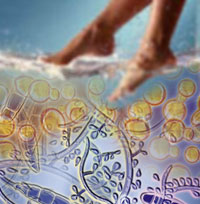Skin fungal infections: Easy to catch and very hard to get rid of
There is a plethora of fungal infections caused by various fungi. It is noteworthy that a clinical manifestation of a fungal disease can be pretty drab at times. That is the reason why certain tests (examining a skin scale or specimen of some other tissue smeared on a microscope slide) must be conducted in order to determine the type of a fungus that infected your body. It is understood that a microscope is not a typical household item, and therefore it is necessary to address immediately to the dermatologist at the occurrence of the first symptoms of a fungus.

The same applies to treatment. Fungi are very viable organisms; they do not give in without a fight. Treatment requires the use of special antifungal antibiotics. Only a dermatologist can prescribe such drugs and supervise treatment.
To earn a fungus is easy in places of public using e.g. swimming pools, baths, saunas, and sports halls. The places have one thing in common: a warm and damp environment. In other words, all of them are a perfect breeding ground for fungi. Anyone who is infected is likely to be a health risk for those living in the same house or apartment because a fungus can be easily transferred through towels, pedicure or manicure accessories.
Athlete’s foot (tinea pedis ) and jock itch (tinea cruris) top the list of the giveaway “souvenirs” one can get in any of the abovementioned places.
Athlete’s foot manifests itself with scaly and itchy patches – typical signs of a fungal infection. The signs of the disease tend to show up in the web spaces between the 4th and 5th toes. A closer examination reveals redness and some tidy cracks in the web spaces. The condition can only get worse if no proper treatment is provided. Scaling, blisters and an offensive smell will render feet completely unfit for walking.
Jock itch is commonly seen in boys and men whose anatomy allows for a warm and moist environment which is ideal for fungal growth. A clinical manifestation of the disease is not necessarily pronounced yet dryness, redness and scaling tend to spread in the groin greases, although the above may sometimes affect the upper inner thigh, buttocks and lower abdomen.
Safety measures
- You should always visit public places (pools, baths, and saunas) in closed rubber slippers, which should be thoroughly washed with soap after each visit; never walk barefoot in a shower.
- Never use somebody else’s towels etc.
- Avoid tight or closed footwear, change socks daily and wear cotton socks, which keep the feet cooler.
- To avert a recurrent case of athlete’s foot, you had better discard flip-flops you used while receiving treatment for the disease.
Years ago you must have heard your mommy warning you repeatedly: “Don’t you touch that stray cat! He may be infested with ringworm…” You were probably bewildered by the warnings: that lovely little kitty looked completely innocuous as it walked around the sandboxes. But your mother was dead right: the charming creature was undoubtedly a host of parasites causing ringworm or tinea corporis, the only fungal skin infection which can easily spread from fungus elsewhere on the skin or from animals. It can also spread from contact with others.
You are at risk for ringworm if you: are the parent of a child who likes stroking stray cats and dogs; play contact sports or recreational activities; have a suppressed immune system. A condition known as Majocchi granuloma is an uncommon yet fairly grave variety of the disease.
The signs include small bumps or granulomas that sometime look like warts. A chronic form of the disease may affect women who shave their legs and the fungus becomes implanted in and around the hair follicle.
Ringworm causes red scaly patches, which are typically ring-shaped. It can affect on the feet, hands and the upper body including hair on the head. Hair is normally cut to the bone in the latter case.
Safety measures
- Never touch stray cats and dogs no matter how cute the animals may look.
- Tell your children to keep away from stray animals at all times.
- Do not hesitate to take your offspring to the dermatologist should you spot the ring-shaped patches on their skin.
Thanks to ubiquitous TV commercials, we seem to be perfectly aware of two major problems affecting women these days i.e. menses and thrush. We are going to talk about thrush or candidosis since menstruation has nothing to do with fungal infections.
Candidosis is a common yeast infection of moist areas of the body, usually caused by Candida albicans, hence the name. It is especially common in the vagina though it can also affect the mouth, skin folds or the intestines. Compared to candidal infection of the bowel, vulvovaginitis does not pose an immediate threat to women’s health. At the same time, it causes plenty of discomfort. In the vagina it produces itching accompanied with a thick, cream discharge. There is usually pain on intercourse. It should be noted that the majority of women experience the condition while many a woman have a chronic form of it, with periods of exacerbation and remission coming and going regularly.
The condition should be treated by the gynecologist. A smear test should be carried out in any case because candidosis often shows on the background of other non-fungal infections, hormonal disruptions and the like. An unbalanced diet (alcoholic beverages, food made from yeast dough) may bring about the production of “creamy stuff.”
Uncircumcised men have good chances of contracting candidal balanoposthitis or inflammation of the foreskin and the surface of the underlying glans penis. The affected area becomes red and swollen, which consequently narrows the opening of the foreskin and makes passing of the urine difficult and painful. An infected man may pass on the infection to all the partners with whom he would have sexual intercourse. In their turn, his partners would pass it back to him in the course of a relationship. In other words, candidal infection would come full circle. All in all, nature took “good care” of men by making them a target for jock itch, which is commonly seen in boys and men. It rarely affects women. The infection shows as a red-brown scaly rash occurring in the groin areas, sometimes with small blisters or pustules at the edge. At times the skin many show a thickened appearance from rubbing or chronic scratching.
Tips to keep a fungal skin infection at bay
- Wash the body daily. Dry the skin carefully after bathing
- Change underwear daily, wash towels daily
- Always seek medical help at the occurrence of the first symptoms of a fungus. Under no circumstances you should interrupt a course of treatment that you have to complete. Always take control tests upon completion of treatment.
- Eschew candy and cake during the course of treatment (the majority of pathogenic fungi live on sugar).
Medportal.ru
Translated by Guerman Grachev
Pravda.ru
Subscribe to Pravda.Ru Telegram channel, Facebook, RSS!


